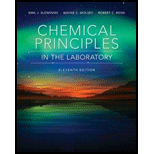
(a)
Interpretation:
The energies in kJ/mol for four lowest energy levels of the
Concept introduction: Bohr’s theory of atoms was applicable to the one electron system. It purposed the energy levels in an atom. It purposed the mathematical relation for the calculation of the radius of orbits, energy and velocity of electrons.
(a)
Answer to Problem 1ASA
Explanation of Solution
The
Thus, the electronic configuration must be=
For the first four energy levels, the value of
(b)
Interpretation: The energies for the transition from n=2 to n=1 level for
Concept introduction: Bohr’s theory of atoms was applicable to the one electron system. It purposed the energy levels in an atom. It purposed the mathematical relation for the calculation of the radius of orbits, energy and velocity of electrons.
(b)
Answer to Problem 1ASA
Explanation of Solution
The atomic number of Beryllium = 4
Thus, the electronic configuration must be=
For the first four energy levels, the value of
The energies for the transition from n = 2 to n = 1 level for
The wavelength will be:
(c)
Interpretation: The quantum number of the initial and final states for the transition of given three wavelengths
Concept introduction: Bohr’s theory of atoms was applicable to the one electron system. It purposed the energy levels in an atom. It purposed the mathematical relation for the calculation of the radius of orbits, energy and velocity of electrons.
(c)
Answer to Problem 1ASA
a) 4 → 1 b) 3 → 1 c) 4 → 3
Explanation of Solution
Calculate energy fir the given three wavelengths
From the part (a):
Thus, the difference in
Hence the
The difference in
The difference in
Want to see more full solutions like this?
Chapter 11 Solutions
Chemical Principles in the Laboratory
 ChemistryChemistryISBN:9781305957404Author:Steven S. Zumdahl, Susan A. Zumdahl, Donald J. DeCostePublisher:Cengage Learning
ChemistryChemistryISBN:9781305957404Author:Steven S. Zumdahl, Susan A. Zumdahl, Donald J. DeCostePublisher:Cengage Learning ChemistryChemistryISBN:9781259911156Author:Raymond Chang Dr., Jason Overby ProfessorPublisher:McGraw-Hill Education
ChemistryChemistryISBN:9781259911156Author:Raymond Chang Dr., Jason Overby ProfessorPublisher:McGraw-Hill Education Principles of Instrumental AnalysisChemistryISBN:9781305577213Author:Douglas A. Skoog, F. James Holler, Stanley R. CrouchPublisher:Cengage Learning
Principles of Instrumental AnalysisChemistryISBN:9781305577213Author:Douglas A. Skoog, F. James Holler, Stanley R. CrouchPublisher:Cengage Learning Organic ChemistryChemistryISBN:9780078021558Author:Janice Gorzynski Smith Dr.Publisher:McGraw-Hill Education
Organic ChemistryChemistryISBN:9780078021558Author:Janice Gorzynski Smith Dr.Publisher:McGraw-Hill Education Chemistry: Principles and ReactionsChemistryISBN:9781305079373Author:William L. Masterton, Cecile N. HurleyPublisher:Cengage Learning
Chemistry: Principles and ReactionsChemistryISBN:9781305079373Author:William L. Masterton, Cecile N. HurleyPublisher:Cengage Learning Elementary Principles of Chemical Processes, Bind...ChemistryISBN:9781118431221Author:Richard M. Felder, Ronald W. Rousseau, Lisa G. BullardPublisher:WILEY
Elementary Principles of Chemical Processes, Bind...ChemistryISBN:9781118431221Author:Richard M. Felder, Ronald W. Rousseau, Lisa G. BullardPublisher:WILEY





